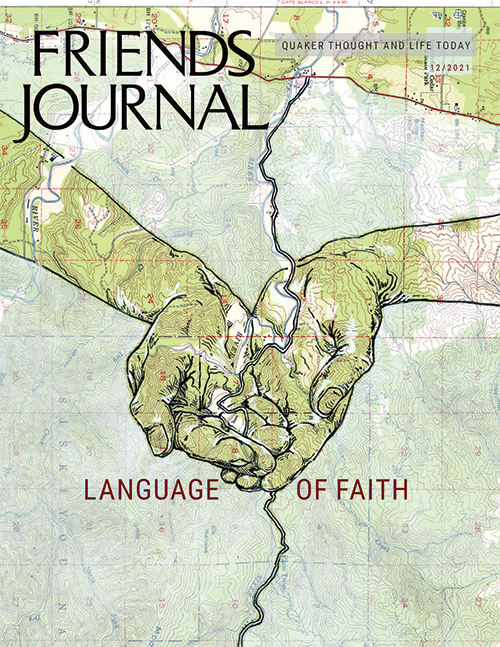Finding Meaning in a Familiar Practice
As meeting for worship comes to a close, there are handshakes and some hugs. Then everyone settles back down in their seats as the moderator inquires, “Are there any additional messages that did not arise during worship?” We pause for a moment and listen to any remaining messages.
Next we move on to announcements. After a mix of announcements regarding changes to the schedule and calendar and reminders of cleaning, maintenance, and upcoming activities, the moderator shifts to other concerns. These are announcements of member hospitalizations or deaths, of those who are homebound or recovering from illness or surgery, and of local or international tragedies. As we offer news of these people and events, the moderator has us pause after each one with these guiding words, “Let us take a moment now to hold them in the Light.”
Not growing up in the Friends tradition, I had been learning about Quakerism through experience and reading. While I had become familiar with the term “Light,” I questioned the meaning of holding someone in the Light. Staying with familiar language, my initial interpretation was “keeping them in our thoughts and prayers.” Yet that seemed superficial. A moment of silent prayer did not seem to fully capture the essence of that pause involved in holding them in the Light. Those pauses felt more like silent worship. Nevertheless silent worship also seemed an incomplete conceptualization to describe this practice.
So I began my search to find meaning in the words and to better understand the practice of holding in the Light. Reading historic and current Quaker writings provided some context and meaning to the Light, but less so on holding in the Light. Attending Quaker meeting, workshops, classes, and retreats did little to further answer this specific question. In talking with Friends, both those who grew up in the Friends tradition and those who joined in adulthood, I found that they struggled to come up with words to explain or describe the process. For years I continued to participate in this practice while studying and praying for insight, but little new understanding came. So I resolved to continue to participate and to trust the process of holding in the Light.
Then I was in a car accident and had bruises from head to toe and a broken leg. Since my parents had notified the meeting of my crisis, a comfort quilt, flowers, and cards greeted me upon my return home. The cards continued to come over the following weeks. So did the pain—even with medication. In the middle of the night, I would awaken in pain. For hours I would await my next dose of medication and pain relief. During those hours, I would cuddle up in the comfort quilt, turn on some instrumental or religious music, read my cards or religious writings by flashlight, and spend time with God in prayer or worship. One of those nights, I yearned not to be alone with my pain. So I sought comfort from those who sent cards. In reading my get-well cards from meeting, I noticed they were signed “Holding you in the Light.” Then as I felt the patches of the comfort quilt, I thought of who may have made them and how they, too, were holding me in the Light.
Turning off my flashlight, I sat in the dark with my pain. With music playing, I continued in worship and prayer. As the playlist shuffled through songs, it came to play a song of a blessing based upon an Old Testament Bible verse: “The Lord bless you and keep you. The Lord make his face shine upon you.” (Num. 6:24–25 NIV)
As the song continued, my thoughts wandered: If the Lord’s face shines upon you, are you not in the Light, the same Light of to be held in? This idea seemed logical and not overreaching. Exploring the idea, I considered who from religious readings has seen that face of the Lord to have it shine upon them. From the Bible, my initial thoughts were of Adam, Abraham, Moses, and from the New Testament, there was Paul. While I knew these people from Bible stories, I was less versed in other religious texts. Yet I thought maybe some of the Catholic saints and Krishna. But were there others? And what would it be like to be in the Light of God’s face shining upon you?
With that thought, I became bathed in a sacred power and majesty. My pain disappeared as I was overwhelmed with love, joy, and peace. In this moment of worship, I experienced a communion like none I had ever known. As I sat in my hospital bed in the darkness, I no longer felt alone. While I know they were not physically present, I began to see faces of members of meeting, other Christian friends and family, and other devout friends from other faith traditions. As this continued, I began to see smiling faces of people that I did not know, complete strangers that seemed to be from across the world. It was as if everyone was smiling and shining their face upon me. Coming away from that experience, I sensed this is what it is like to be held in the Light.
The Quaker belief is that of God is in all people. Likewise when someone shines their face upon you, in a simple smile, you are being held in the Light. These everyday experiences have not been as dramatic as my initial understanding. Your experience might be different. Nevertheless I hope sharing this experience provides insights into the meaning of the phrase “to hold in the Light.”







From Paul Harris: “Surprisingly, this phrase only first appeared in Quaker writings about forty years ago. Nowadays we tend to think of the Light as love and grace and everything good, but early Friends believed the “Inward Light” illuminates the dark places of our souls, exposes the corruption that needs to be healed. To experience the searching of that Light can be painful, especially when we’re feeling resistant to change.”
Being “held in the Light” meant to be held accountable to Sprit. Like turning on the Light in the dark attic of our soul, it is not always pleasant to face what we find there, but is the first step to moving forward in our spiritual journey.
We can also hold in the Light those who are struggling, but we cannot direct the Light what to do with them. As
Chris Bobbitt says, “‘I will hold thee in the Light’ means, I will hold the person having trouble up into the purifying Light which is God/Spirit and let the Light shine howsoever it will. That could be many directions, not mine to specify.”
Thanks for the insightful review, Bruce. I think John Dominic Crossan in his little book, The Dark Interval, first made me aware that such light, even when termed as God’s judgment, is a divine gift letting us recover those aspects of ourselves we had repressed and suppressed not wanting them to be seen in the light. That judgment and discovery light is given in love to us, and sensing divine presence in it, we can then begin to know how to grow in that light and be open to it.
A non-quaker friend told me of receiving a serious medical diagnosis and feeling fragile and frightened, overwhelmed by her feelings. She sent a text to a dozen close friends telling them of the news and asking them not to text or call (she didn’t have the emotional strength to deal with them) but to pray for her. Within minutes, she felt a rush of peace and her fear dissipated. She and I are convinced that somehow, something was transmitted to her.
When I “hold someone in the Light” I have to center down / open up / let go, before I can hold them. I wonder if that process of centering down allows our energy to become coherent instead of the messy fragmented energy we usually live in. We are told, by physicists, that particles can influence other particles at a distance. I wonder if by allowing our own energy to become more coherent and thinking of the other person, we help their energy become more coherent, less fragmented, fractured. They might experience that as peace, love, or joy.
Dana expresses my own experience of holding others in the light, at least those times when I am being truly mindful and taking the time to pause and focus and not simply flashing a name across my brain. Recently a group of us held a friend in the light as he was dying. Afterward many spoke of the energy they felt as we all envisioned our friend surrounded in light. When we hold others in the light, we ourselves are encircled in that same sphere of energy and love.
That is what I believe.
John Hamer
Thanks Bruce for adding these. As you presented, being “Held in the Light” has been used with various meanings in differing situations. Also–in early Quaker writings, there is reference not only to “Inward Light”, but “the Light Within”. They seem to be different concepts. Nevertheless, I have seen “hold in the Light” utilized in Meetings to reference both of the interpretations presented above.
I have been struggling for some time with the idea of verbal prayer. Sometimes it feels like a manipulation of the Spirit. I appreciate on the other hand the quietness of holding someone in the light. It seems to come from a deeper place within, a spiritual yearning of the whole of oneself for the good of the other. This is important this night for me as my partner has just been taken to hospital. Of course I can pray with words, but holding in the light, hoping that the divine presence will shine upon him, seems more powerful. Or is it simply another way of saying, we become prayer, a prayer beyond words, as the Spirit already knows our hearts?
Thanks for this piece, Ruthanne. I am new to Quakerism and, like you, have been wondering about the meaning of the phrase “hold in the Light” I keep hearing.
Your flashlight analogy feels spot-on. I think of Christ, the self-proclaimed light of the world, shining into the darkness that does not understand it. Also of the radiance of the Transfigured Christ beaming out to all in his presence.
Even if another is struggling and stuck in a dark place, through prayer we can move their spirit into the warm, beautiful, healing light of the risen Christ as an act of love. This is what it means to be church.